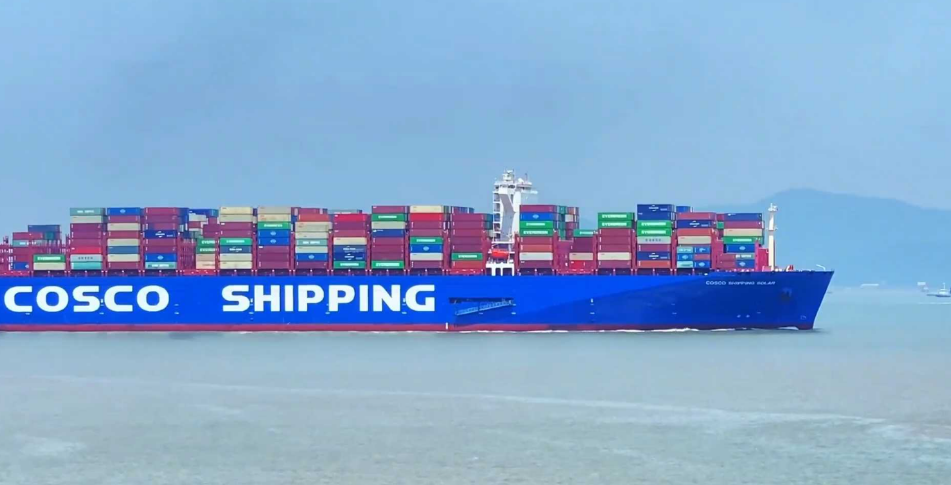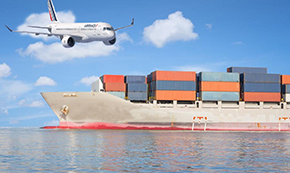All categories >
What are the differences between international sea freight and direct shipping, and how should I choose?
Categories:
Industry Encyclopedia
Solution
Time of issue:
2025-06-26 12:03
Views:

In international trade and cross-border logistics, sea freight, as a major mode of transportation with lower costs and suitability for bulk cargo, is widely used. In practice, sea freight is divided into two transportation methods: direct (direct shipping) and transshipment (transfer). The following will detail their differences and how to choose between them.
I. Basic Concepts of Sea Freight Transshipment and Direct Shipping
(I) What is direct sea freight?
Direct sea freight, also known as direct shipping or direct delivery, refers to the transportation method where cargo is transported directly from the port of loading to the port of destination without changing ships or transhipping through other ports. It is usually arranged by large shipping companies with fixed routes, covering major trading ports.
- Features
- Faster voyages, shorter transportation time
Since there is no need to stop at other ports for loading, unloading, and ship changes, the goods can be transported directly to the destination port, reducing transit time.
- Simple operation as cargo does not need transshipment after loading
After loading cargo at the port of loading, it is only unloaded at the port of destination, reducing intermediate operations and lowering the risk of damage or loss due to multiple loading and unloading.
- Low error rate, high cargo security
By reducing the transshipment process, the possibility of errors such as misloading and omission during transshipment is reduced, and the risk of theft and damage of goods at the transshipment port is also reduced, improving the safety of cargo transportation.
(II) What is sea freight transshipment?
Sea freight transshipment, also known as transshipment or ship change, refers to the transportation of goods from the port of loading to a transshipment port (Hub Port), where the goods are changed to another ship or wait for consolidation, and then transported to the port of destination by another ship.
- Features
- Can reach more non-mainstream ports, more flexible routes
For some remote or smaller ports, there may not be direct routes connecting the port of loading, but transshipment can achieve cargo transportation, allowing goods to reach more different destinations.
- Relatively low freight rates, suitable for non-urgent, bulk cargo
Transshipment routes can usually utilize the transport capacity and route networks of different shipping companies to optimize resource allocation and reduce transportation costs. For goods with low time requirements and large volumes, choosing transshipment can save logistics costs.
- Transshipment time is not fixed and may have delays
Cargo needs to wait for loading, unloading, and ship changes at the transshipment port. The operational efficiency of the transshipment port, the schedule of subsequent ships, etc., may all affect the transshipment time. If congestion, equipment failure, or other unexpected situations occur at the transshipment port, the goods may stay at the transshipment port for a long time, leading to transportation delays.
II. Core Differences between Direct Sea Freight and Transshipment
(I) Transportation route and operation process
Direct transportation is where cargo sails directly from the port of loading to the port of destination, and the container remains on the same ship throughout the transportation process without changing ships. Transshipment, however, requires unloading the cargo from one ship at the transshipment port and then loading it onto another ship for continued transportation. For example, shipping from Shanghai, China to New York, USA. If direct shipping is chosen, the cargo is loaded onto a ship at Shanghai Port and sails directly to New York Port; if transshipment is chosen, the cargo may first be transported to Busan Port, South Korea, unloaded, and then transferred to another ship bound for New York.
(II) Transportation time
Generally, direct shipping, without the transshipment process, has a relatively short and stable transportation time. However, the actual transportation time is affected by various factors, such as ship schedule, loading and unloading time, customs declaration and clearance speed, sailing speed, weather, and sea conditions. Sometimes, the schedule of direct shipping may be unreasonable, leading to long waiting times, or low efficiency in loading and unloading cargo at the port, which will increase the transportation time.
Transshipment, due to the need for ship changes at the transshipment port, usually takes longer than direct shipping. Moreover, the transshipment time is uncertain. If the transshipment port has low operational efficiency, or the schedule of the subsequent large ship is not well-connected, cargo may be delayed at the transshipment port, further extending the transportation time. However, in some well-designed transshipment routes, transshipment may also be faster than some roundabout direct routes.
(III) Transportation cost
The transportation cost of direct shipping is relatively high because shipping companies need to invest in dedicated ship resources for direct shipping routes to ensure that cargo can be transported directly to the port of destination. At the same time, direct shipping usually serves larger ports, which have relatively higher operating costs, potentially increasing freight costs. However, when shipping companies have promotions or sufficient space, preferential freight rates may also be obtained for direct routes.
Transshipment can integrate cargo from different ports of loading, reducing unit transportation costs through economies of scale, resulting in relatively lower freight rates. In addition, transshipment ports usually have certain logistics hub advantages, providing more economical loading, unloading, and transshipment services, which also helps reduce costs.
(IV) Cargo risk
Direct shipping, with fewer cargo loading and unloading times, reduces the risk of damage, loss, or misloading during transportation. For high-value, fragile goods, direct shipping is a more ideal choice.
Transshipment, as cargo needs to be unloaded and reloaded at the transshipment port, increases the possibility of damage, loss, or misloading. Especially when the transshipment port is busy or operations are not standardized, the cargo risk will further increase. Therefore, for high-value, fragile goods, the risk of transshipment is relatively high; while for bulk ordinary goods and non-perishable goods, the risk of transshipment is acceptable, and its cost-effectiveness is higher.
III. How to choose a sea freight method
(I) Based on whether the destination port has direct shipping
First, confirm whether there are direct ships to the destination port. If it is a remote small port or an emerging market, it may only be accessible through transshipment. For example, some secondary ports in Africa, South America, and Southeast Asia are usually not in the main direct shipping network. If the destination port does not have direct shipping services, then transshipment is the only option.
(II) Based on transportation time requirements
If customers have strict requirements for delivery time, such as urgent order delivery or seasonal products (e.g., Christmas gifts), it is recommended to prioritize direct routes to ensure timely delivery. For time-sensitive goods, even if the direct shipping cost is higher, choosing direct shipping is worthwhile to avoid breaches of contract or loss of sales opportunities due to delays. If the delivery time of the goods is relatively relaxed, although transshipment takes longer, it can be arranged in advance through reasonable planning, and its lower freight advantage can be used to reduce costs.
(3) Consider the transportation cost budget
Although transshipment is time-consuming, the freight is usually cheaper. For price-sensitive customers or large quantities of low-value goods, transshipment routes can be considered to save logistics costs. For example, for large quantities of low-value goods such as building materials and coal, cost is the primary consideration during transportation, and transshipment can greatly reduce logistics costs while meeting transportation needs. However, if the goods are of high value and small weight or volume, even if the direct shipping cost is relatively high, considering the value of the goods and the transportation risk, direct shipping may still be a more suitable choice.
(4) Analyze the type of goods and risk tolerance
1. High-value, fragile goods
Direct shipping is recommended to reduce the risk of mid-transit operations. For goods such as electronic products, precision instruments, and high-end clothing, damage during transportation may cause significant economic losses. Direct shipping reduces the number of loading and unloading times, effectively reducing the risk of damage to goods and ensuring the safety of goods.
2. Bulk ordinary goods, non-perishable items
Transshipment is also acceptable, with high cost-effectiveness. For goods such as food and daily necessities, they are relatively insensitive to transportation time and loss during transportation. Choosing transshipment can ensure the safe delivery of goods while reducing transportation costs and improving overall economic efficiency.
Both transshipment and direct shipping in sea transportation have their applicable scenarios and advantages. Direct shipping is suitable for high timeliness and high security requirements, while transshipment is suitable for saving costs and expanding port coverage. When choosing international sea transportation methods, cargo owners need to comprehensively consider the destination port situation, transportation timeliness requirements, transportation cost budget, and the type and risk tolerance of goods, and make the most suitable decision for their own needs after weighing the pros and cons.
Shenzhen Huijietong International Freight Forwarding Co., Ltd. - Professional US Line Transportation Service
In the field of US line transportation, Shenzhen Huijietong International Freight Forwarding Co., Ltd. has become the trusted choice of many customers with its professional services and rich experience. Shenzhen Huijietong International Freight Forwarding Co., Ltd. focuses on US line transportation and provides comprehensive logistics solutions, including sea freight, air freight, land transportation, and warehousing services. The company maintains close cooperation with major shipping companies and can provide flexible space arrangements and efficient transportation services according to customer needs.
Choosing Shenzhen Huijietong International Freight Forwarding Co., Ltd. means choosing professional, efficient, and reliable logistics services. For more details, please visit [Huijietong official website www.szvif.com
For the US, choose Huijietong!
Shenzhen Huijietong International Freight Forwarding Co., Ltd., your professional US line transportation partner.
Service hotline: 0755-82171929 13560787209

WeChat QR code
Keywords:
US Line Transportation,Transportation services,Sea freight direct,Sea transshipment










